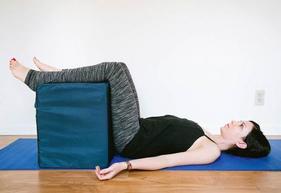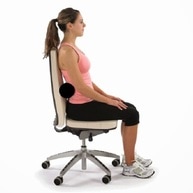
The static back (or 90/90) position
For this position, you simply lay on the floor with your hips and knees bent to 90 degrees and have your lower legs resting on a chair or couch. This position is great as it takes a lot of pressure off of the lower back. It is also great for your hips. Generally you can lay in this position for up to 20 minutes.
Note: If you are in lots of pain, getting down onto the floor can be problematic. You can do the same thing on a bed, simply put a chair onto the bed and repeat as above. Once the pain eases, you can then transition to the floor.

There is a lot of debate about using ice or heat. Please read my blog posts on this topic here and here. I discuss in detail what is best to use and when. My general rule of thumb is if you hurt yourself use ice for the first 24 hours. After that use heat. The other key point is that if you use ice, only apply it for 10 minutes at a time. If you use heat, apply it for 20 minutes at a time to get the best results. The reasoning for this is explained in the blog post linked above.
Use a chair properly
As a generalization, with a sore lower back it is going to be best to sit in a chair with a straight back (like a dining or computer type chair), rather than a couch. Invariably in couches we tend to slouch which won’t make your sore lower back very happy. Sit with your bum pushed to the back of the chair and if needed place a small pillow or rolled up towel in your lower back to help maintain a good posture. If you do sit in a couch, make sure you are sitting back in the couch with the pillow or towel across the lower back to help avoid aggravation.
One thing pain does is make us move better (you won’t be bending and twisting in poor positions if you are sore). If you do have a sore back, proper movement is going to be of utmost importance. When I say movement I am talking about things like getting in and out of a chair, bed or off of the toilet. I am also talking about lifting things and bending. To do these properly, it is best to try and avoid too much bending of the spine. Here are a few tips:
- When getting in and out of a chair, keep your back flat and use your legs. When sore people often want to push off of their legs. By doing this you tend to round the lower back which can cause discomfort.
- To get out of a bed safely, start by rolling onto your side facing out from the bed. Use your arms to push yourself up to a sitting position. As you push yourself up, drop your legs over the side in a pendulum type fashion. Once sitting facing away from the bed, you can then use your legs to stand up.
- If you have a sore lower back, it is best to try and avoid lifting and bending as much as possible. If you do have to lift, make sure you use the correct lifting technique and again, use your legs and not your back.
Being able to create a proper abdominal brace using your core muscles is something we should all be doing. It becomes vitally important when you have a sore lower back. Creating an abdominal brace is not just sucking your belly in. In order to create the tension in the area, contract your core muscles like you are bearing down to go the toilet or what you would do if someone was going to punch you in the stomach. You need to tense the muscles so that your lower back is as stable as it can be. To get an idea of the tension required, try this simple exercise. It is best to do it lying down as shown below, but can also be done standing:
- Find the hip bones on the front of your pelvis.
- Bring your fingers an inch towards the midline.
- When you are relaxed, this area will be soft.
- Keeping your fingers on this spot, tense the core muscles until you feel the muscles tightened under your fingers. This is the tension you should generate when you are going to lift. Often it is more than people think.
When you are sore and have to bend of lift something you need to consciously get ready to move so you can do it safely. Initially you will need to do this consciously step by step until it becomes subconscious. Here is how to do it:
- Get into a good postural position. Stand up tall with shoulders back and down and some tension in your glutes.
- Brace your core as described above.
- Bend or lift with good technique as described above whilst maintaining the abdominal bracing.
- Once you have finished the movement you can then release the abdominal brace.
So there are a few simple tips that I have found to be important as well as effective for people who are suffering from a sore lower back. Please try them and see what you think. Of course if you are having ongoing problems, it is well worth having a proper assessment to see why the pain is there in the first place. For more information about this or to make an appointment, contact us here.
References
- Image: http://sportandspinehealth.com/blog/truth-proper-posture-hk.html
- Image: http://www.highspeedtraining.co.uk/hub/manual-handling-techniques/
- Image: https://www.youtube.com/watch?v=_Eye7bGQqt4





 RSS Feed
RSS Feed


